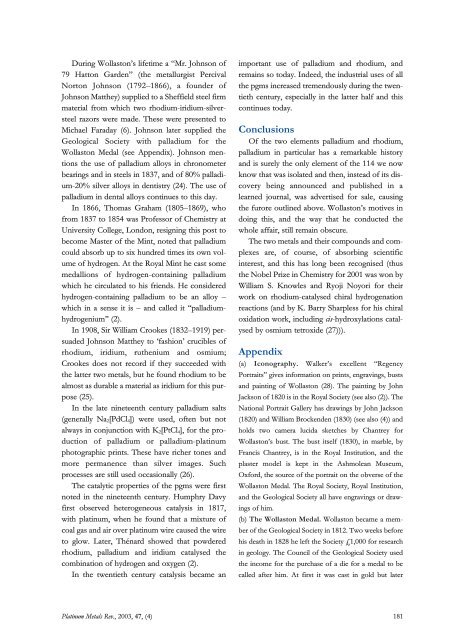Bicentenary of Four Platinum Group Metals - Platinum Metals Review
Bicentenary of Four Platinum Group Metals - Platinum Metals Review
Bicentenary of Four Platinum Group Metals - Platinum Metals Review
You also want an ePaper? Increase the reach of your titles
YUMPU automatically turns print PDFs into web optimized ePapers that Google loves.
During Wollaston’s lifetime a “Mr. Johnson <strong>of</strong><br />
79 Hatton Garden” (the metallurgist Percival<br />
Norton Johnson (1792–1866), a founder <strong>of</strong><br />
Johnson Matthey) supplied to a Sheffield steel firm<br />
material from which two rhodium-iridium-silversteel<br />
razors were made. These were presented to<br />
Michael Faraday (6). Johnson later supplied the<br />
Geological Society with palladium for the<br />
Wollaston Medal (see Appendix). Johnson mentions<br />
the use <strong>of</strong> palladium alloys in chronometer<br />
bearings and in steels in 1837, and <strong>of</strong> 80% palladium-20%<br />
silver alloys in dentistry (24). The use <strong>of</strong><br />
palladium in dental alloys continues to this day.<br />
In 1866, Thomas Graham (1805–1869), who<br />
from 1837 to 1854 was Pr<strong>of</strong>essor <strong>of</strong> Chemistry at<br />
University College, London, resigning this post to<br />
become Master <strong>of</strong> the Mint, noted that palladium<br />
could absorb up to six hundred times its own volume<br />
<strong>of</strong> hydrogen. At the Royal Mint he cast some<br />
medallions <strong>of</strong> hydrogen-containing palladium<br />
which he circulated to his friends. He considered<br />
hydrogen-containing palladium to be an alloy –<br />
which in a sense it is – and called it ‘‘palladiumhydrogenium’’<br />
(2).<br />
In 1908, Sir William Crookes (1832–1919) persuaded<br />
Johnson Matthey to ‘fashion’ crucibles <strong>of</strong><br />
rhodium, iridium, ruthenium and osmium;<br />
Crookes does not record if they succeeded with<br />
the latter two metals, but he found rhodium to be<br />
almost as durable a material as iridium for this purpose<br />
(25).<br />
In the late nineteenth century palladium salts<br />
(generally Na 2[PdCl 4]) were used, <strong>of</strong>ten but not<br />
always in conjunction with K 2[PtCl 4], for the production<br />
<strong>of</strong> palladium or palladium-platinum<br />
photographic prints. These have richer tones and<br />
more permanence than silver images. Such<br />
processes are still used occasionally (26).<br />
The catalytic properties <strong>of</strong> the pgms were first<br />
noted in the nineteenth century. Humphry Davy<br />
first observed heterogeneous catalysis in 1817,<br />
with platinum, when he found that a mixture <strong>of</strong><br />
coal gas and air over platinum wire caused the wire<br />
to glow. Later, Thénard showed that powdered<br />
rhodium, palladium and iridium catalysed the<br />
combination <strong>of</strong> hydrogen and oxygen (2).<br />
In the twentieth century catalysis became an<br />
important use <strong>of</strong> palladium and rhodium, and<br />
remains so today. Indeed, the industrial uses <strong>of</strong> all<br />
the pgms increased tremendously during the twentieth<br />
century, especially in the latter half and this<br />
continues today.<br />
Conclusions<br />
Of the two elements palladium and rhodium,<br />
palladium in particular has a remarkable history<br />
and is surely the only element <strong>of</strong> the 114 we now<br />
know that was isolated and then, instead <strong>of</strong> its discovery<br />
being announced and published in a<br />
learned journal, was advertised for sale, causing<br />
the furore outlined above. Wollaston’s motives in<br />
doing this, and the way that he conducted the<br />
whole affair, still remain obscure.<br />
The two metals and their compounds and complexes<br />
are, <strong>of</strong> course, <strong>of</strong> absorbing scientific<br />
interest, and this has long been recognised (thus<br />
the Nobel Prize in Chemistry for 2001 was won by<br />
William S. Knowles and Ryoji Noyori for their<br />
work on rhodium-catalysed chiral hydrogenation<br />
reactions (and by K. Barry Sharpless for his chiral<br />
oxidation work, including cis-hydroxylations catalysed<br />
by osmium tetroxide (27))).<br />
Appendix<br />
(a) Iconography. Walker’s excellent “Regency<br />
Portraits” gives information on prints, engravings, busts<br />
and painting <strong>of</strong> Wollaston (28). The painting by John<br />
Jackson <strong>of</strong> 1820 is in the Royal Society (see also (2)). The<br />
National Portrait Gallery has drawings by John Jackson<br />
(1820) and William Brockenden (1830) (see also (4)) and<br />
holds two camera lucida sketches by Chantrey for<br />
Wollaston’s bust. The bust itself (1830), in marble, by<br />
Francis Chantrey, is in the Royal Institution, and the<br />
plaster model is kept in the Ashmolean Museum,<br />
Oxford, the source <strong>of</strong> the portrait on the obverse <strong>of</strong> the<br />
Wollaston Medal. The Royal Society, Royal Institution,<br />
and the Geological Society all have engravings or drawings<br />
<strong>of</strong> him.<br />
(b) The Wollaston Medal. Wollaston became a member<br />
<strong>of</strong> the Geological Society in 1812. Two weeks before<br />
his death in 1828 he left the Society £1,000 for research<br />
in geology. The Council <strong>of</strong> the Geological Society used<br />
the income for the purchase <strong>of</strong> a die for a medal to be<br />
called after him. At first it was cast in gold but later<br />
<strong>Platinum</strong> <strong>Metals</strong> Rev., 2003, 47, (4) 181
















